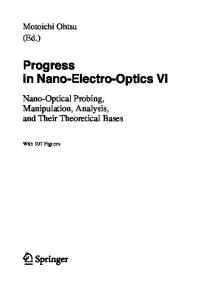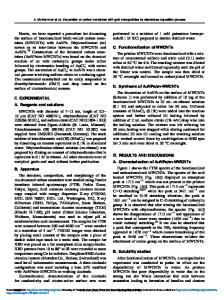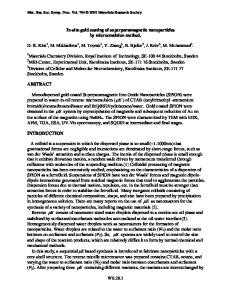Analysis of the Formation Process of Gold Nanoparticles by Surface-Assisted Laser Desorption/Ionization Mass Spectrometr
- PDF / 223,479 Bytes
- 4 Pages / 595.276 x 790.866 pts Page_size
- 67 Downloads / 394 Views
J. Am. Soc. Mass Spectrom. (2013) 24:305Y308 DOI: 10.1007/s13361-012-0541-5
APPLICATION NOTE
Analysis of the Formation Process of Gold Nanoparticles by Surface-Assisted Laser Desorption/Ionization Mass Spectrometry Iva Tomalová,1 Chia-Hsin Lee,2 Wen-Tsen Chen,2 Cheng-Kang Chiang,2 Huan-Tsung Chang,2 Jan Preisler1 1 2
CEITEC MU and Department of Chemistry, Faculty of Science, Masaryk University, Kamenice 5, Brno( Czech Republic Department of Chemistry, National Taiwan University, 1, Section 4, Roosevelt Road, Taipei 106, Taiwan Abstract. Chemical reactions of reducing agents in the gold nanoparticle (AuNP) formation process were characterized using surface-assisted laser desorption/ ionization mass spectrometry (SALDI-MS). As the reaction of the AuNPs progresses, the produced AuNPs can serve as an efficient SALDI substrate. SALDI-MS revealed that the reducing agents and their oxidation products can be determined in the mass spectra. With respect to the transmission electron microscopic and UV-Vis spectroscopic examination of AuNPs, SALDI-MS results confirm not only the tendency toward AuNPs formation, but also reflect the information of the redox reaction process. Our results provide useful information for developing SALDI-MS methods to explore the chemical information regarding the surface behavior between adsorbates and nanomaterials. Key words: Nanomaterials, Gold nanoparticle, Surface-assisted laser desorption/ionization mass spectrometry, SALDI, Nanoparticle formation process Received: 30 August 2012/Revised: 9 November 2012/Accepted: 14 November 2012/Published online: 11 January 2013
D
ue to their stability, size-related electric, magnetic and optical properties, as well as the ease of the surface modification with various ligands, gold nanoparticles (AuNPs) have been the subject of extensive interest in many fields including nanotechnology, electronics, and material science [1, 2]. AuNPs have been synthesized by various methods that are based usually on the reduction of chloroauric acid in the presence of a stabilizing (capping) agent. The most common method is the reduction of chloroauric acid by trisodium citrate [3] or NaBH4 [4]. However, with the increasing attention paid to nanomaterials, less traditional reducing agents including amino acids [5–7], proteins [8, 9] or even lemongrass extract [10] have been employed to prepare AuNPs in recent years. Up to now, numerous methodologies have been employed to explore the surface morphologies and lattice structures of AuNPs, including Auger electron spectrometry,
Electronic supplementary material The online version of this article (doi:10.1007/s13361-012-0541-5) contains supplementary material, which is available to authorized users. Correspondence to: Huan-Tsung Chang; e-mail: [email protected], Jan Preisler; e-mail: [email protected]
energy dispersive spectrometry, secondary ion mass spectrometry [11], X-ray absorption near-edge spectroscopy, and X-ray photoelectron spectroscopy [12]. Although several optical and electrochemical approaches have b
Data Loading...










